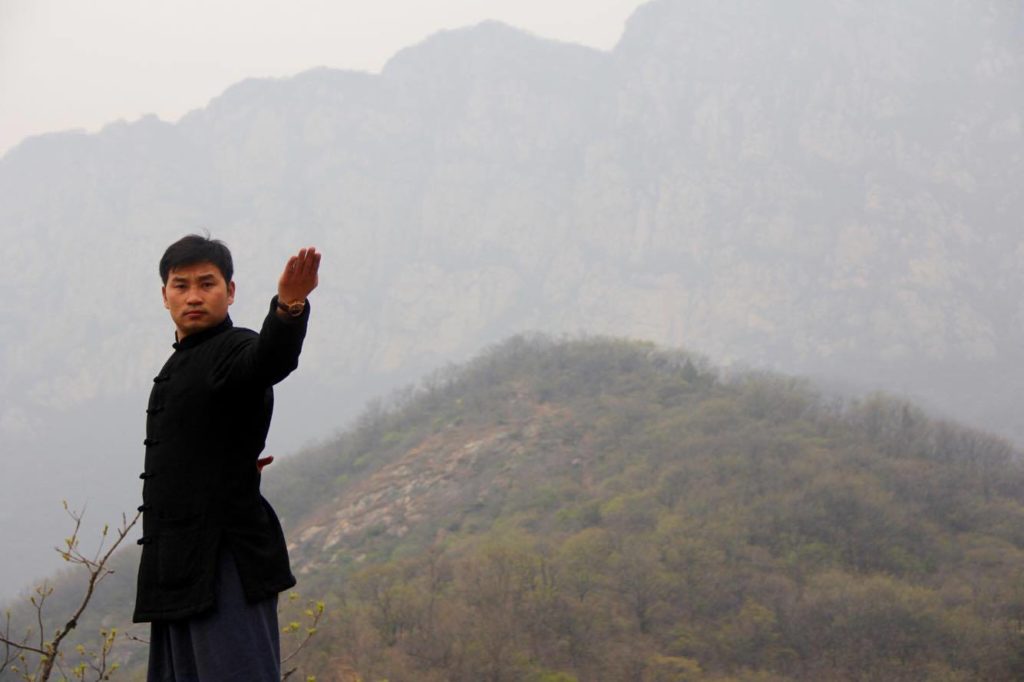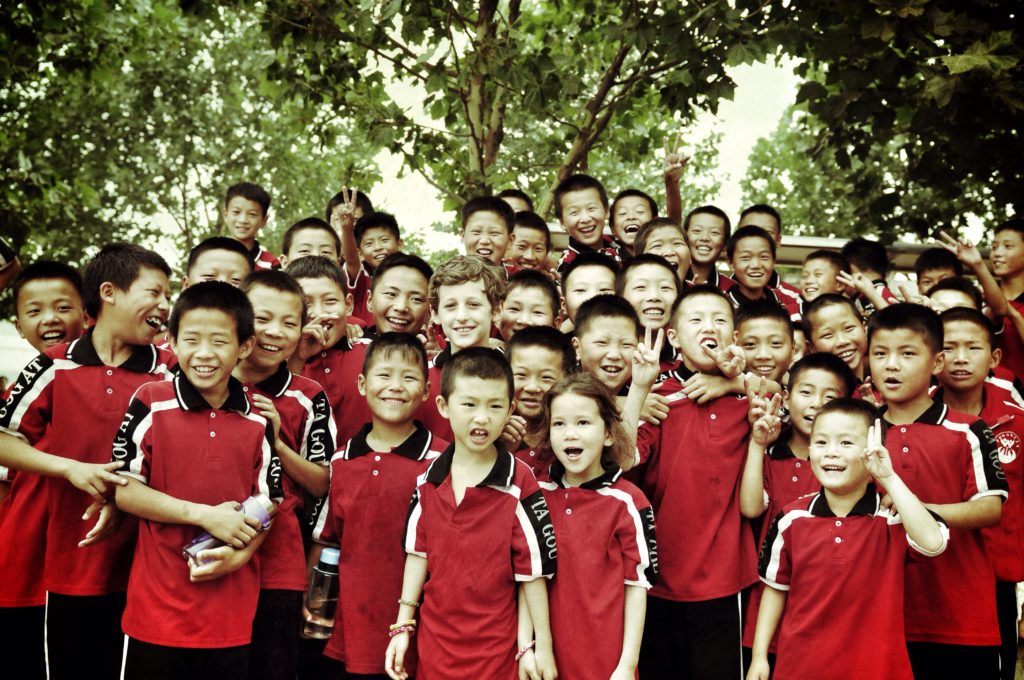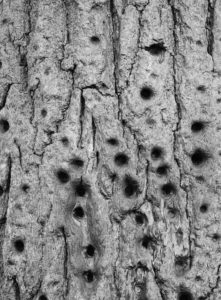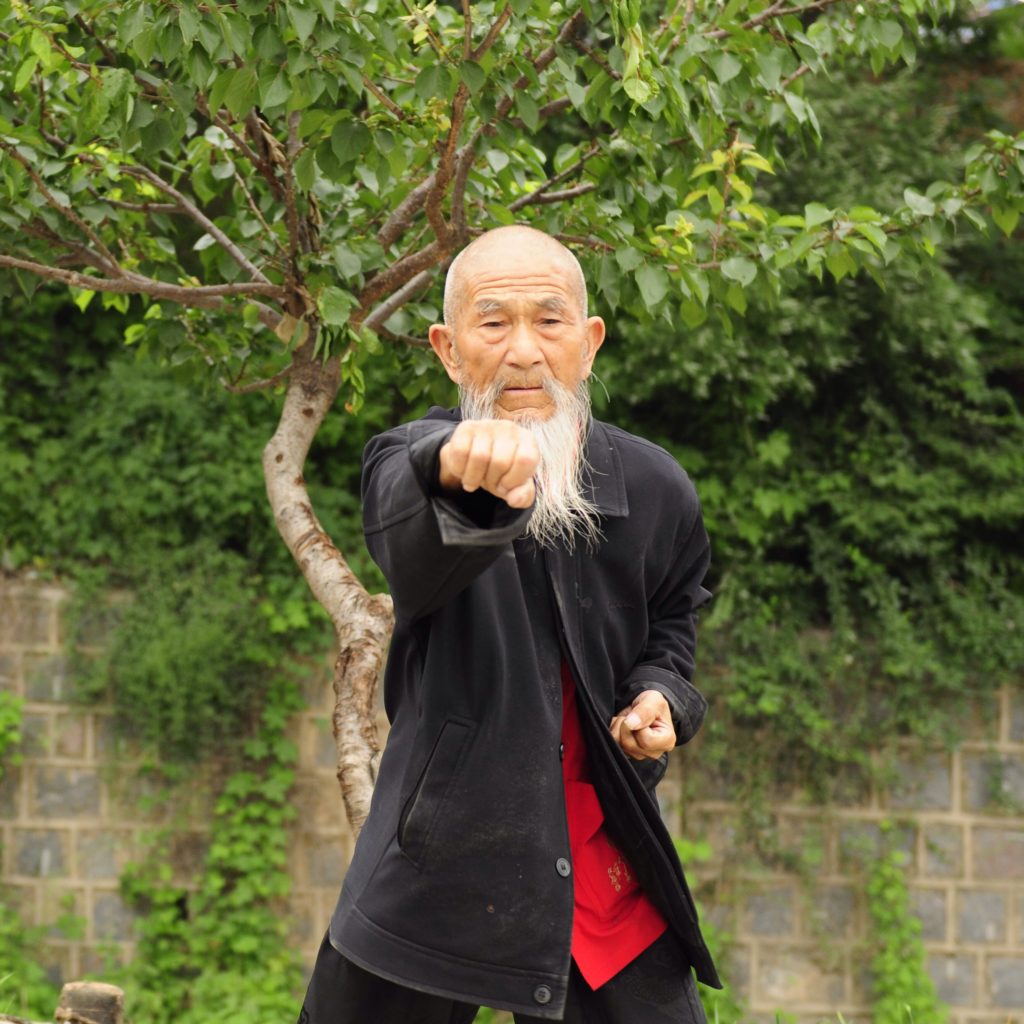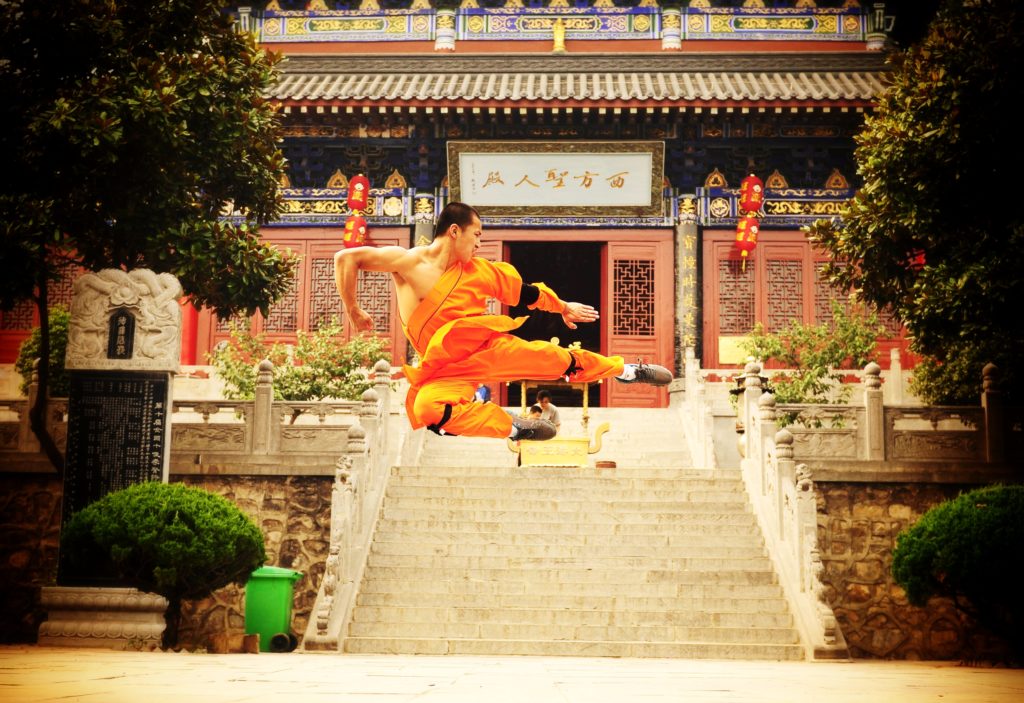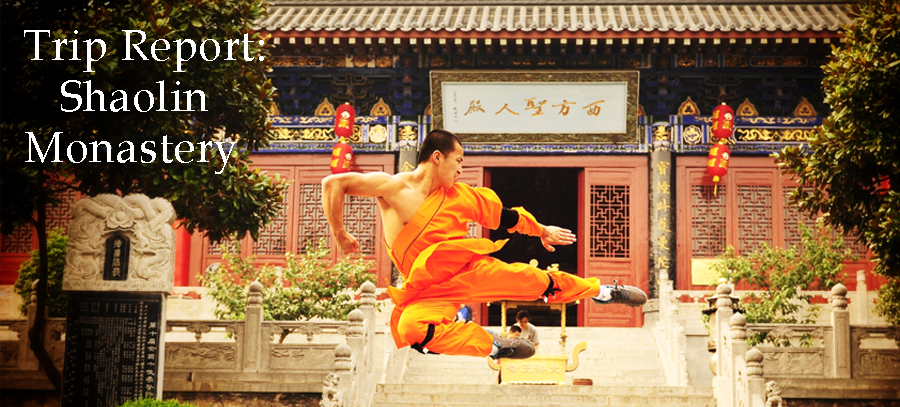 Today’s Field Agent trip report comes from Elizabeth A. Hoffman, who lived in Beijing for nearly six years. Elizabeth is a psychologist and a photography enthusiast. She can be found in Washington, DC exploring human behavior and staking out her next travel adventure.
Today’s Field Agent trip report comes from Elizabeth A. Hoffman, who lived in Beijing for nearly six years. Elizabeth is a psychologist and a photography enthusiast. She can be found in Washington, DC exploring human behavior and staking out her next travel adventure.
I could scarcely hold a tree pose, let alone a double-edged sword, so training with Kung Fu masters at an ancient Buddhist Temple seemed just right. -Elizabeth Hoffman
Wushu Warriors
As the school year’s end looms – our sixth and last in Beijing – I daydream about a final travel adventure, one that might test the grit we have honed over the years. We love China and hold tight our Beijing life, helplessly counting the days until repatriation to the U.S. This endless ending, not totally unlike Bill Murray’s repeated and failed seduction of Andie MacDowell in Groundhog Day, feels bleak. A trip could offer new opportunities for memory-making, and maybe a pretense that the end is not near. After some sleuthing, I find what I am looking for: a brochure from a Kung Fu show amidst orphaned photos and ticket stubs at the back of a junk drawer. It advertises fall and late winter excursions to the Shaolin Temple, one of the holiest Buddhist monasteries in China.
I email the organizer, Liu Lao Shi, with my question, Shaolin in June?? and wait barely a minute before my phone dings with his reply: Shaolin in June?? Yes! Mei wen ti. No problem! We can plan a trip for the end of the month. A few days later he follows up with more details. We will travel by fast train to Luoyang in Henan Province, about 700 kilometers west of Beijing, and then continue on to Shaolin by car where we will stay for several days. Besides training in Shaolin Wushu, a traditional non-combat martial art form that Buddhist monks developed in the Shaolin Temple centuries ago, there would be sightseeing to grottos and neighboring towns, and socializing with students who live and study near the monastery. Total cost per person is 3000 renminbi (about $490 US) and covers all of our lodging, food, transportation (including a private driver), training and entrance fees. My kids can’t wait to go and are momentarily distracted from goodbyes and leaving parties. Forgetting that I am about as flexible as a stick, I’m in too and arrange to meet Liu at his training studio the next week with 6,000 rmb cash deposit stuffed in my pockets.
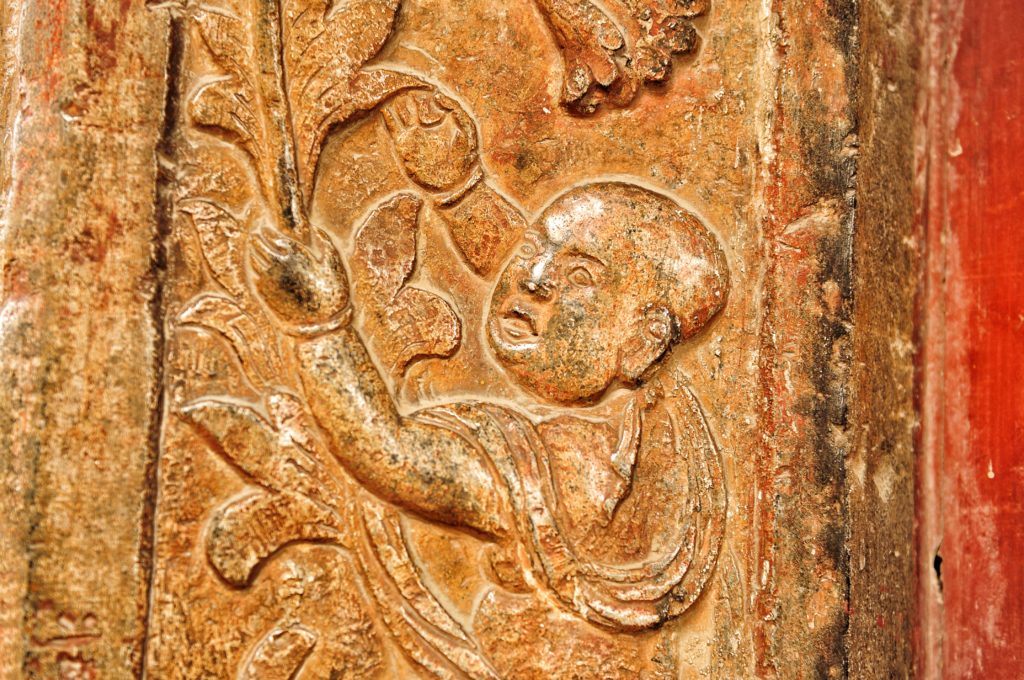 A couple of days before departure, Liu contacts me again, this time offering advice to make our stay more comfortable. “Bring shampoo”, he says, “and a towel because you will not have
A couple of days before departure, Liu contacts me again, this time offering advice to make our stay more comfortable. “Bring shampoo”, he says, “and a towel because you will not have
towel at the hotel. We will buy soap when we get there and maybe toilet paper. Bed is hard but you will be so tired you will sleep like a small baby.” I make a mental note to toss a roll of TP in my duffel. And heeding the advice of a friend, I add sleeping bags to my list in case we need extra cushioning.
Liu completed his training 15 years ago at the Ta Gou School, one of about 20 Wushu academies that surround the Shaolin Temple, and the biggest with several thousand students ranging in age from 4-18. He spent ten years there, taking a week off annually to celebrate Chinese New Year with family. Training was not for the uncommitted. Each day students practiced their Wushu forms for 12-15 hours with unrelenting instruction – punishment for mistakes was common and sometimes painful – and performed what I imagine are bone-crushing calisthenics. The schedule changed little from one day to the next (except Sunday) and included breaks for communal meals, brief rests and chores. Academic subjects – mathematics, Chinese and science – were taught by resident teachers from 7-10 pm each evening, after which students returned to their rooms to rest up for a 6:00 a.m. wake-up call. Sunday was a day to relax, at least in comparison to training days. Students mopped and dusted their rooms, wrote letters home, caught up on schoolwork, and washed their clothes and Wushu shoes. Cleaning one’s shoes each week so that they appeared white again and nearly new was a serious job. If you didn’t do it perfectly you disrespected your teachers, your peers, your parents, the Ta Gou school, the entire Wushu sport, and yourself. When training resumed Monday morning, prefects inspected each pair of shoes for total spotlessness and if the wearer failed inspection he was disciplined with one-hour wall sits outside the main building – the offending shoes were perched on his head for the whole world to see as they headed to breakfast.
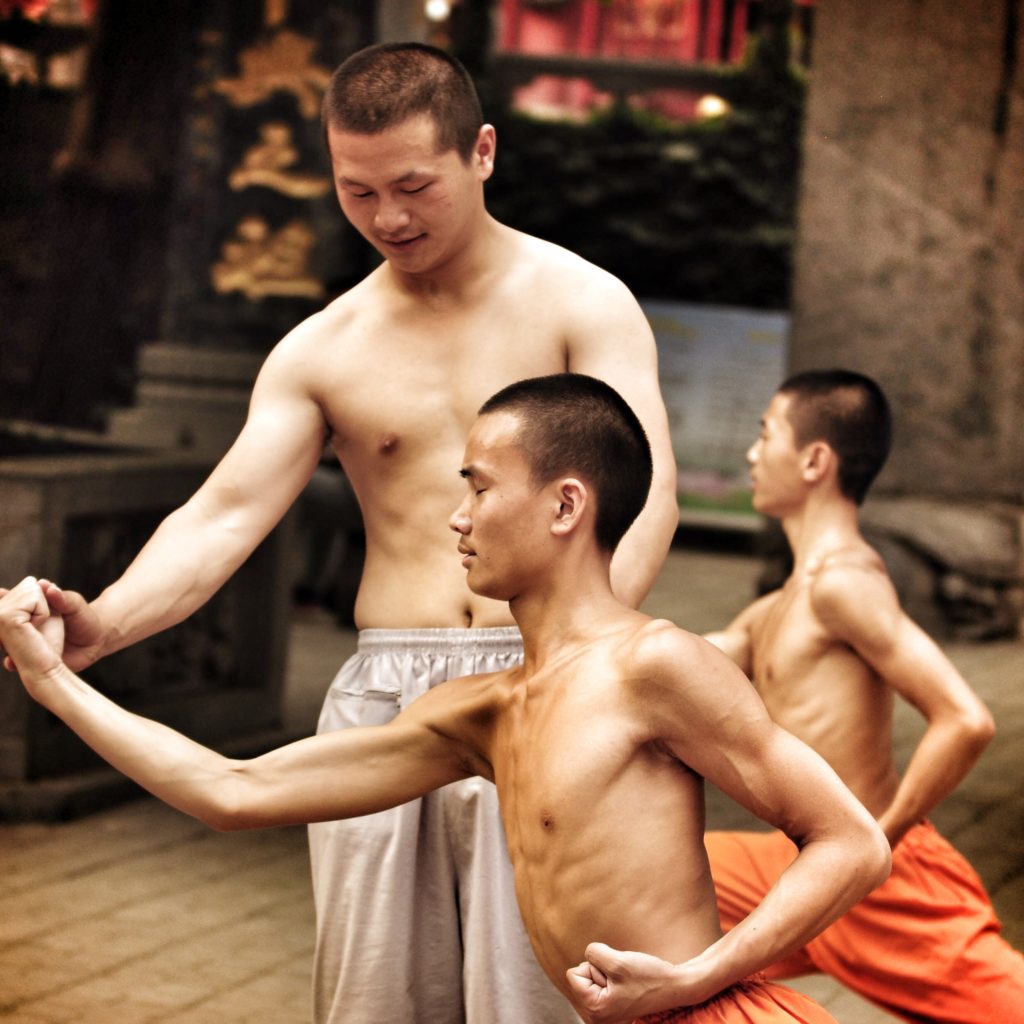 Not much has changed in the years since Liu was a student, except that punishment for imperfect form is arguably less severe. Back in Liu’s time, students were hit across their bare backs if they didn’t do the form right. Throughout training, instructors held sticks in full view, as if daring their students to mess up. Nowadays, the sticks are still taunting, but beatings have been replaced by ear pulling, pokes, and dragging wooden rods across the back, leaving
Not much has changed in the years since Liu was a student, except that punishment for imperfect form is arguably less severe. Back in Liu’s time, students were hit across their bare backs if they didn’t do the form right. Throughout training, instructors held sticks in full view, as if daring their students to mess up. Nowadays, the sticks are still taunting, but beatings have been replaced by ear pulling, pokes, and dragging wooden rods across the back, leaving
splinters and scrapes behind. Questioning the instructor still is discouraged but not forbidden. Liu likens his training years to growing up in North Korea though he’s never been there. When their schooling finished, many of his peers moved to cities, in hopes of landing stable jobs, but had difficulty integrating into society. They had little idea how to think independently, to ask questions. Some drove taxis. Most did not continue with Wushu, though a few got parts in Kung Fu films or became master instructors as Liu had done. One of Liu’s classmates panicked when a Beijinger asked him what he thought of big city living upon arrival in the nation’s capital. He returned to his home province a few months later to help out on the family farm.
Some time during the trip I ask Liu why parents bring their kids – some just four or five years-old – to study at Wushu academies for years on end. Many show early promise in the sport, he tells me, and their parents believe that rigourous and continual instruction is a gift. Others go to learn the value of hard work and good behavior, or because their parents are too busy to take care of them. Would Liu send his kids to Ta Gou? At 6 and 10, they both are exceptional athletes and study Wushu as diligently as their father. Liu tells me that he regrets not a day that he spent at Ta Gou. He made life-long friends, developed a passion for his life’s work, and learned discipline and perseverance that he is now able to pass on to his children as an enduring lesson, no matter their chosen path. My son asks me this too, Liu says, and always the answer is the same: the sacrifice is too high. There is too much to bear. I was lucky.
Duffels packed and extra granola bars shoved into backpacks, we head to the Beijing West train station on a Wednesday morning to meet our group – Liu and his daughter, and one of Liu’s youngest students, a Beijingren, who brings along his mother and grandparents. The ride is comfortable and quick. In just a few hours we are in Luoyang, having shared fruit and tea and watched the kids giggle and make wacky faces, too shy to speak the other’s language.
Our first stop is a Wushu accessories and clothing store a couple of kilometers from the Shaolin Temple. The shop is empty except for the shopkeeper and his wife who is unpacking a box of belts when we step inside. The shopkeeper taps cigarette ashes onto a small mound of ramen
and a piece of lotus root while smoke dances around us, leaving taupe-colored stains on the floor samples and manequins. Liu explains that we have just arrived and need clothes since Ta Gou does not allow students to train without a uniform. “Hao, hao, hao, ok”, the man says, and offers a lopsided grin before pulling out cellophane-wrapped robes for us to try. After a quick glance to size us up, Liu selects a few pairs of pants plus a sword for his daughter and a small, jade elephant. He pays quickly and we hop back in the car to head to the school commissary for polo shirts with Ta Gou emblazoned on the front. As we approach the entrance gate, we see a young boy circling his mother who is attempting to have a conversation with a school official. Holding a small bag of snacks and another with his belongings, the boy looks around doubtfully while his mother and the official rub his hair and try to make him laugh. The boy’s uniform is crisp but hangs awkwardly, his shirt collar torqued to one side like it’s trying to get away.
Ta Gou is a tidy expanse of training rooms, practice fields and dormitories. It is lunchtime when we arrive so students mill around informally. When they spot Liu, there are high-fives and muffled smirks at his latest crew. After touring the school and watching a few Wushu forms practiced by some of the more talented students, including a boy from New York who has been a resident at Ta Gou for the last six months and announces proudly that he is no longer pudgy, and a tiny boy who turns out to be 10 but looks five or six (Liu makes him stand next to Aidan, my 10-year-old son, who clears him by at least six inches), we are taken to our hotel near the center of town for a rest.
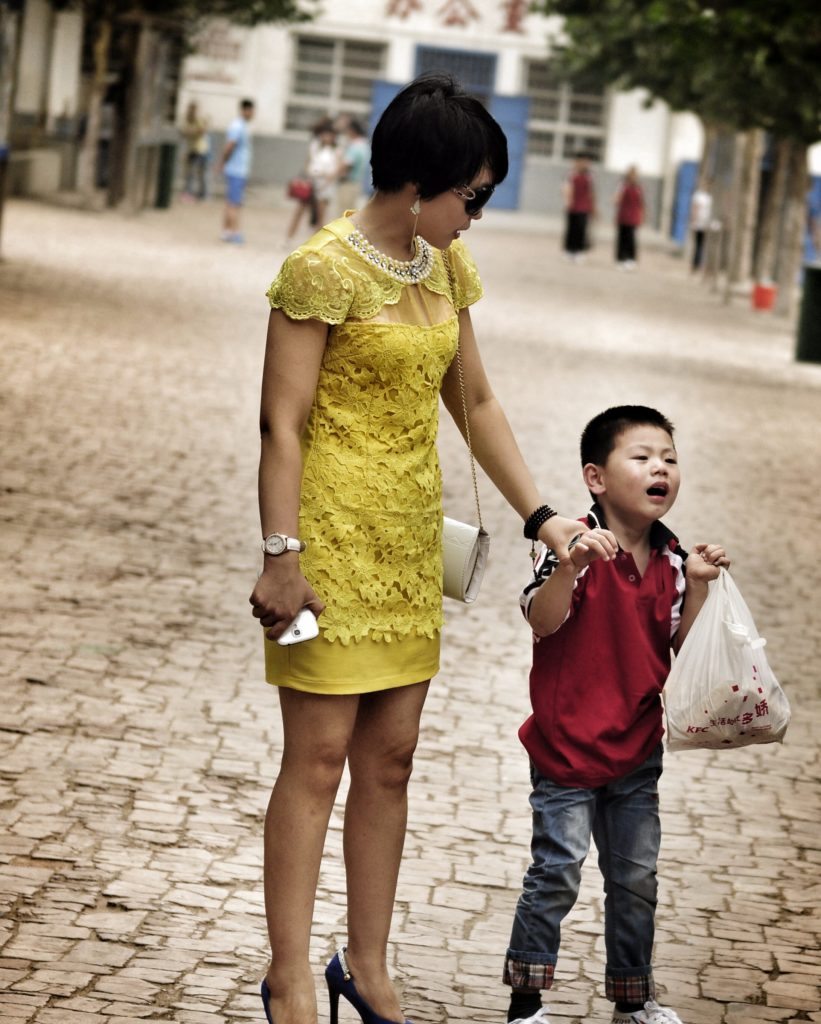 Situated at the end of a small, winding alley, next to a residential lane, the hotel is under partial construction and seems nameless. Small groupings of uniformed students have gathered outside eating ice cream they picked up from a nearby vendor and laughing at a neighborhood toddler who holds a Popsicle in each hand and is joyously naked. Wearing bulky, down coats, other students run in a line around the perimeter of the quarter, their sweat spraying one another as they pause every few meters to do jumping jacks. “They need to sweat out extra weight so that they can be in the lighter weight division”, Liu says. Soon they will strip down to their boxers and eat ice pops to cool off, only to start the process again a few moments later.
Situated at the end of a small, winding alley, next to a residential lane, the hotel is under partial construction and seems nameless. Small groupings of uniformed students have gathered outside eating ice cream they picked up from a nearby vendor and laughing at a neighborhood toddler who holds a Popsicle in each hand and is joyously naked. Wearing bulky, down coats, other students run in a line around the perimeter of the quarter, their sweat spraying one another as they pause every few meters to do jumping jacks. “They need to sweat out extra weight so that they can be in the lighter weight division”, Liu says. Soon they will strip down to their boxers and eat ice pops to cool off, only to start the process again a few moments later.
The proprietor welcomes us inside a small entryway that doubles as the dining area for him and his wife. Nearby are two cooktops, a collection of bamboo chopsticks, a rice cooker, two woks, and a giant soup ladle. I think about the gadgetry in my own kitchen – an apple corer, that thing that takes the crusts off sandwiches, vegetable peelers, juicers, various whisks with sad egg faces on the handles, three different spatulas (none of which is textured exactly right, my husband laments daily) – and wish I could whittle it all down to chopsticks and a couple of woks. No more hunting around for the garlic press or strawberry stem remover. A woman smiles in our direction and tosses Sichuan peppercorns into a wok. Beside her are small bowls of minced garlic, ground pork, and green beans, the beginnings of gan bian si ji dou (dry fried string beans). Soon everything has been emptied into the wok and the dish is nearly ready. The garlicky, smoky steam that fills the room almost compels me to pull up a stool and tuck right in but this would be so far out of my universe of general gutlessness that I blush at the thought. Instead I mumble something like, “your dish I smell it a lot very good food eating big plate!” and settle for a gentle welcome and an offer to show us to our room. Liu is right about the beds. They are wooden boxes with a thin piece of foam on top, but our sleeping bags provide an easy, if not luxurious, fix.
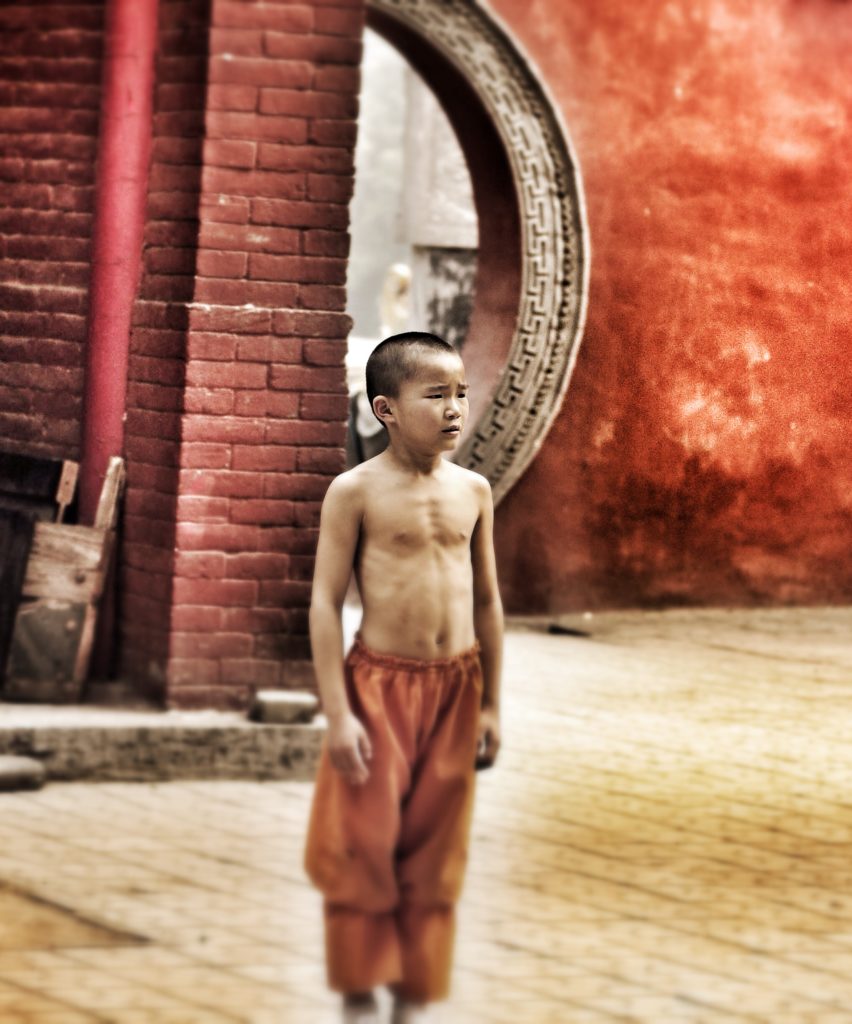 After a short rest, we change into our Ta Gou uniforms and head to a park near the Temple to train with Liu and one of his former students who is now an instructor at the school. For our first lesson we are told to stand like a tree, rooted so that no one can knock us over. Aidan is still contemplating his pose when Liu moves him a few feet and admonishes him to practice before an old, healthy tree, but never before one that is old and sick. Its roots brittle and exposed, Aidan’s abandoned tree leans to one side providing shade for its healthier neighbor. “It’s probably eight or nine hundred years old”, Liu estimates. The trunk is riddled with small craters that look like an aggressive bird’s pecking, or maybe bullet holes, it’s hard to tell. Our eyes trained, we now see that many of the trees around us are similarly disfigured, even the hearty ones. Beginning fifteen hundred years ago, Liu explains, long before there were
After a short rest, we change into our Ta Gou uniforms and head to a park near the Temple to train with Liu and one of his former students who is now an instructor at the school. For our first lesson we are told to stand like a tree, rooted so that no one can knock us over. Aidan is still contemplating his pose when Liu moves him a few feet and admonishes him to practice before an old, healthy tree, but never before one that is old and sick. Its roots brittle and exposed, Aidan’s abandoned tree leans to one side providing shade for its healthier neighbor. “It’s probably eight or nine hundred years old”, Liu estimates. The trunk is riddled with small craters that look like an aggressive bird’s pecking, or maybe bullet holes, it’s hard to tell. Our eyes trained, we now see that many of the trees around us are similarly disfigured, even the hearty ones. Beginning fifteen hundred years ago, Liu explains, long before there were
punching bags, Shaolin students wrapped tree trunks with layers of cloth and practiced their forms over and over and over – kicking and finger-punching, barefooted and bare handed.
When our instructor is satisfied that we can complete two movements from one Wushu form, it is time for dinner. (Full disclosure: at the end of the lesson, he announces that Olivia, my 12-year-old, is the best and I am “very, very bad”, and this affirmation holds up all the way through the completion of the eighth movement a couple of days later when he asks me, befuddled and exasperated, “why are you the worst?”).
We walk over to the main courtyard of the school where students line up outside the cafeteria holding small kettles. Liu motions for us to join the line and passes each of us a kettle. The cafeteria workers ladle in soupy noodles, a bit of meat and some vegetables and we head outside again to find someplace to eat. All around us boys as young as five are sitting on the ground, or propped against a wall, grabbing prime dining space wherever they can and laughing and chatting with friends while they slurp their soup. It is hard to believe that in 20 minutes smiles will vanish from these carefree faces, replaced with tight jaws and squared shoulders ready to resume training. The boys eat quickly. Few get seconds because you have to pay extra and they pocket their change for more soda instead. Some toss a ball around or run down the hill to the basketball court. Others stretch and throw kicks and punches at the air until it is time to go. As the boys file out of the courtyard, Liu takes us down a narrow lane to where the older boys live. He shows us a room that houses six boys and is mostly bare except for bunk beds and an industrial fan. Each boy is allowed one spare pair of shoes. There are few clothes about and virtually no possessions, but for a couple of Chinese movie posters from the 1990s taped to the wall and a communal radio. The fan is a fairly recent add-on, Liu says, recalling more crowded and stinkier lodging in his day. After a few more stops along the lane and stories from Liu, It is time to return to our rooms to rest up for the next day’s activities – more training and maybe a Temple run. My muscles throb already and I can’t wait to shut my eyes. As we round the lane to the main road, we pass a small room with a row of classrooms where students about Aidan’s age sit curiously awake at their desks, notebooks open and newly sharpened pencils gathered in tidy piles.
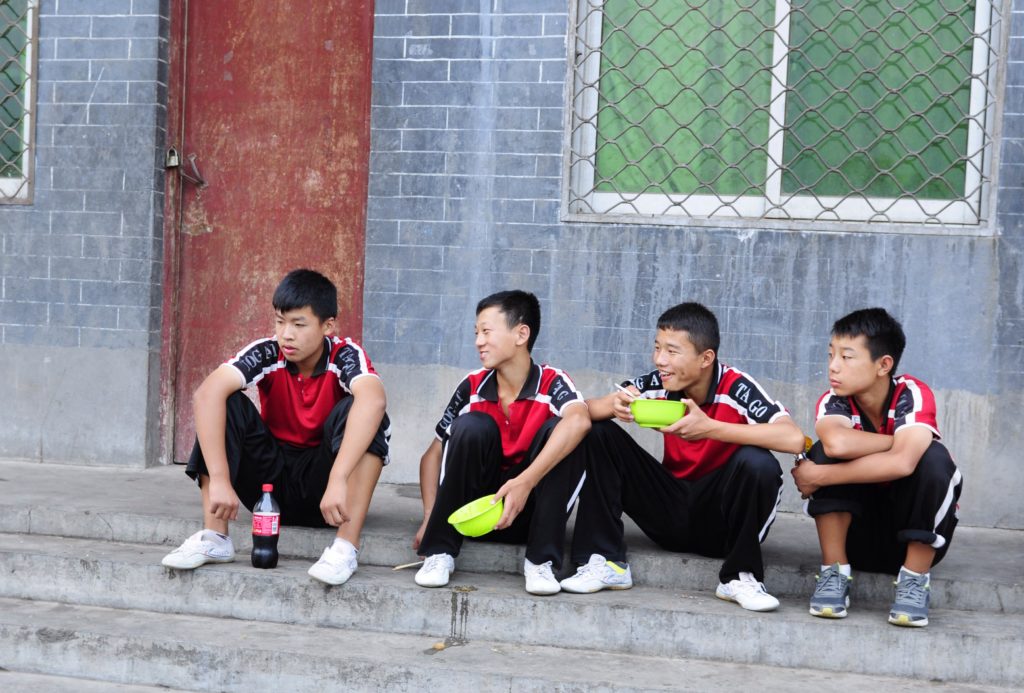 Some time in the middle of the night there is a pounding at the door. I sleep through it for a while but then come to, remembering that I have two little people sleeping next to me. I lumber toward the noise, slightly pissed that I can’t remember anything from training earlier that day but ready to fake it if necessary. Then, “Elizabeth, are you awake now?” I glance at the clock – 6:30. “Time to eat breakfast!” It’s Liu. “You should hurry. Come to the courtyard across the street dressed in your uniforms, ready for training.” I
Some time in the middle of the night there is a pounding at the door. I sleep through it for a while but then come to, remembering that I have two little people sleeping next to me. I lumber toward the noise, slightly pissed that I can’t remember anything from training earlier that day but ready to fake it if necessary. Then, “Elizabeth, are you awake now?” I glance at the clock – 6:30. “Time to eat breakfast!” It’s Liu. “You should hurry. Come to the courtyard across the street dressed in your uniforms, ready for training.” I shove lovingly coax the kids out of bed, grab a couple of Starbucks packets and instant oatmeal from our stash, and we run out. Besides the others in our group, the courtyard is filled with local residents, a few foreigners, and some stray dogs who seem sleepy and over-fed by the time we get there.
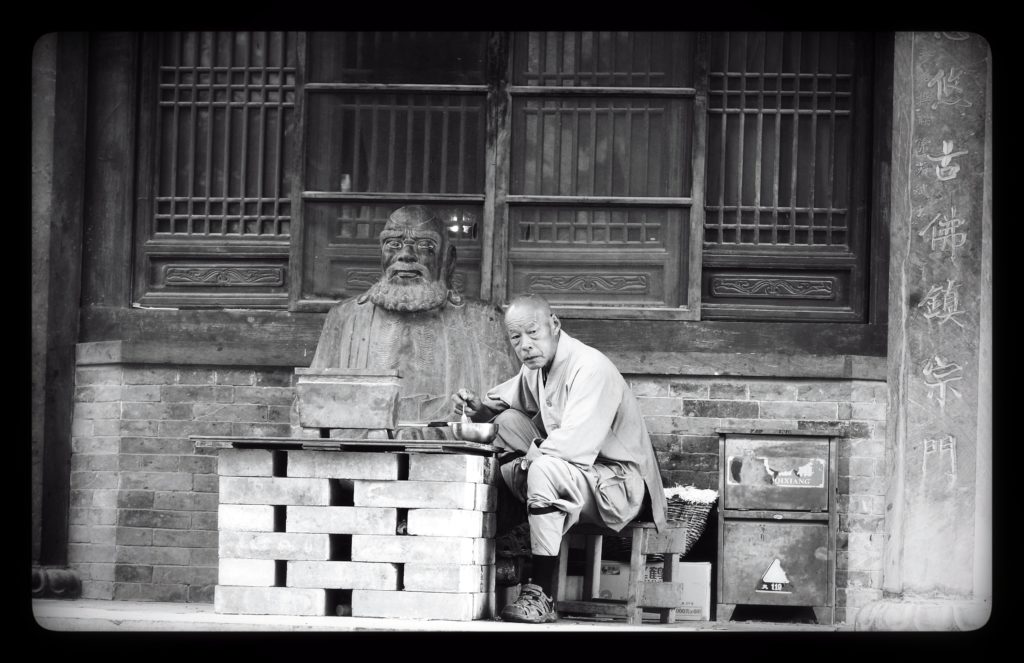 We sit down at an unoccupied table with a thermos of hot water and steamed buns. Soon, a platter of stir-fried egg and tomato appears, followed by shredded pork with leek, fried potatoes and bell peppers, steamed congee, and bok choy with roasted garlic. Liu’s daughter gives us an orange. Olivia tears a hunk from a bun and retrieves a jar of peanut butter from her backpack. Aidan asks for bowls and makes oatmeal for himself and his sister. We all eat some of the potatoes and a bit of pork, and I consume the entire plate of egg and tomato and nearly all of the bok choy. Muscles fueled and caffeinated, we are ready to punch some trees.
We sit down at an unoccupied table with a thermos of hot water and steamed buns. Soon, a platter of stir-fried egg and tomato appears, followed by shredded pork with leek, fried potatoes and bell peppers, steamed congee, and bok choy with roasted garlic. Liu’s daughter gives us an orange. Olivia tears a hunk from a bun and retrieves a jar of peanut butter from her backpack. Aidan asks for bowls and makes oatmeal for himself and his sister. We all eat some of the potatoes and a bit of pork, and I consume the entire plate of egg and tomato and nearly all of the bok choy. Muscles fueled and caffeinated, we are ready to punch some trees.
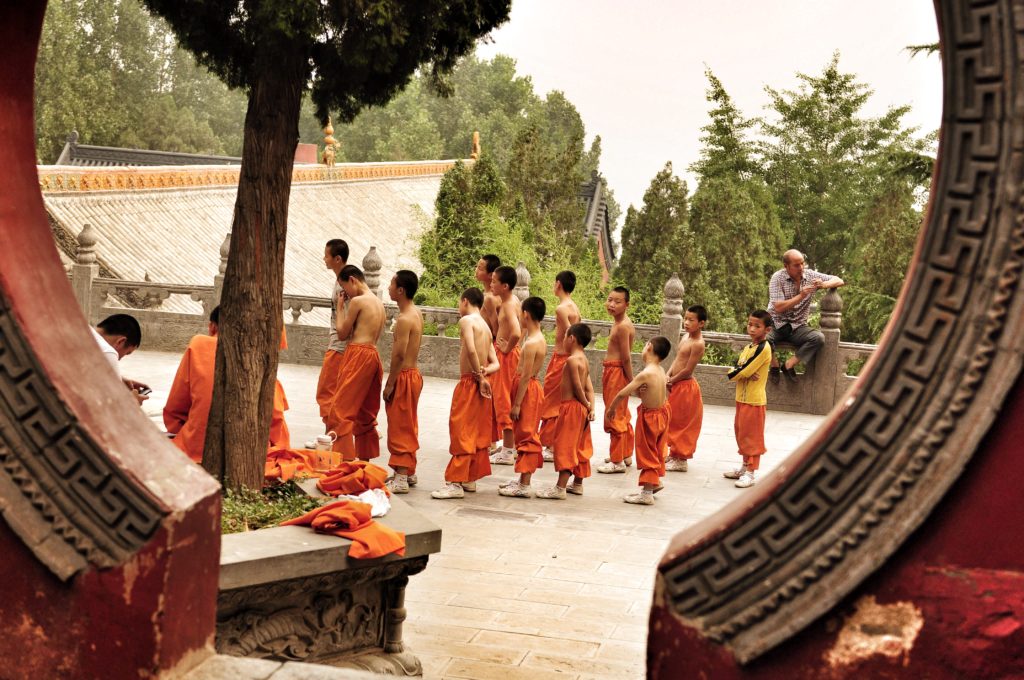 On the way to our riddled tree park, Liu takes us to Ta Gou to watch some practices. Inside the main workout room is a motley group – a middle-aged French man with his son, the boy from New York, who waves to Aidan as if they are old school buddies and haven’t seen each other in decades, a few kids on a camp excursion, and Ta Gou students with their instructors. “Zuo, zuo!” A student is doing heel palm kicks across one length of the room and after each smack the teacher tells him to do it again, his voice rising each time, gaze fixed on the chalky line that cakes the mat and guides his student’s stance. In another corner, a teacher drags a wooden rod swiftly across the small of his student’s back. The boy is young – he looks about 7 – and in the middle of a form. You can see water welling in his eyes but he doesn’t waiver. He just begins again, and then again. Liu pulls aside an older boy from a group exercise and they have a quick conference. The boy laughs and runs outside, returning a minute later with a pile of bricks and a grin that takes up his whole face. Liu makes a pyramid with five of the bricks, then hands
On the way to our riddled tree park, Liu takes us to Ta Gou to watch some practices. Inside the main workout room is a motley group – a middle-aged French man with his son, the boy from New York, who waves to Aidan as if they are old school buddies and haven’t seen each other in decades, a few kids on a camp excursion, and Ta Gou students with their instructors. “Zuo, zuo!” A student is doing heel palm kicks across one length of the room and after each smack the teacher tells him to do it again, his voice rising each time, gaze fixed on the chalky line that cakes the mat and guides his student’s stance. In another corner, a teacher drags a wooden rod swiftly across the small of his student’s back. The boy is young – he looks about 7 – and in the middle of a form. You can see water welling in his eyes but he doesn’t waiver. He just begins again, and then again. Liu pulls aside an older boy from a group exercise and they have a quick conference. The boy laughs and runs outside, returning a minute later with a pile of bricks and a grin that takes up his whole face. Liu makes a pyramid with five of the bricks, then hands
another to the boy who studies it and flips it around several times before finally placing it on top. Students have gathered around by now. Some inspect the bricks, and look for deep fissures or other signs of forgery that would quell our awe but find none. The boy stands a meter or so from the doubters. He closes his eyes and lifts his arm but then retracts. He does this a few more times. “Zuo, zuo!” The doubters chant. And then, thwack! The brick splits right down the middle. The boy turns toward Liu, cups his hand and bows, then returns to his instructor while we go to lunge and kick by the sick trees.
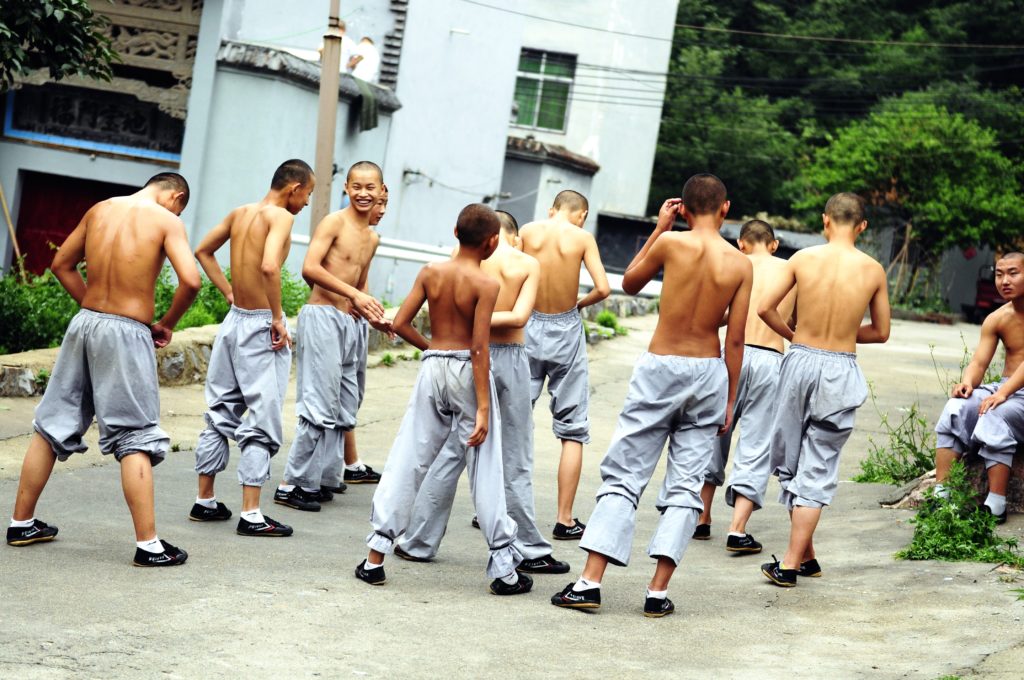 We learn three more Wushu movements to add to the first two which means that we are half way through one form, a series of mostly hand and arm movements meant to build muscles and tendons called Gong Li Quan, and by my calculation, perilously close to performance day. So far I have been given a verbal lashing for giggling twice during practice. The transformation that will need to take place before we are ready to do an actual, for real show I cannot imagine, so I don’t. And curiously, no one speaks of it again until the very last day.
We learn three more Wushu movements to add to the first two which means that we are half way through one form, a series of mostly hand and arm movements meant to build muscles and tendons called Gong Li Quan, and by my calculation, perilously close to performance day. So far I have been given a verbal lashing for giggling twice during practice. The transformation that will need to take place before we are ready to do an actual, for real show I cannot imagine, so I don’t. And curiously, no one speaks of it again until the very last day.
Deftly sidestepping a swarm of bees, Liu leads us away from the trees and across the lawn toward the Temple courtyard. He runs up the steps of the main hall as fast as he can, then hops down, two at a time, and runs back up again, shouting at us to follow. On our third trip down, he turns Aidan into a wheelbarrow – grabs his legs so he has to use his arms to navigate the steps. This works okay until the last few when Aidan yanks free and rolls the rest of the way down, howling with startled glee. Thinking her turn is next, Olivia disappears into a tiny room with a calligraphy table and a collection of brushes and practices character writing until it is time to hike to the nuns’ convent for lunch. The rest of us run up and down the steps, not even trying to keep up with Liu, and pause whenever possible to watch Shaolin students practice their forms at the base of the Temple.
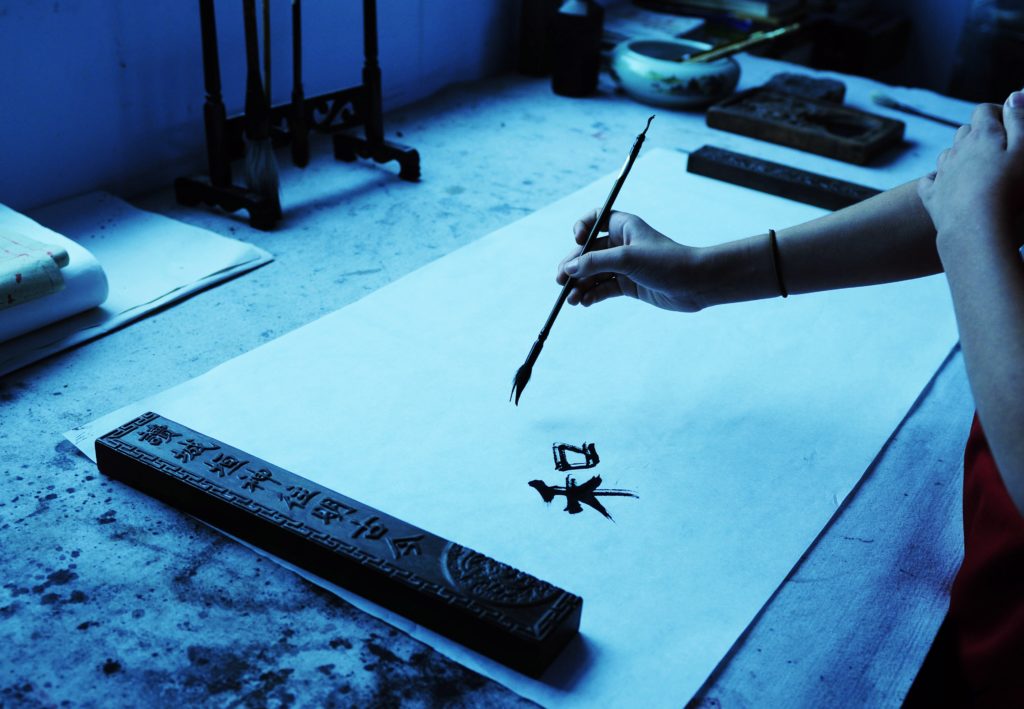 We reach the convent’s doors after a twenty-minute climb through a section of the Temple that has not been restored. Two elderly nuns greet us with cups of tea and an invitation to relax in the shade until lunch is ready, but my eyes fix on a mountain of stones behind the courtyard
We reach the convent’s doors after a twenty-minute climb through a section of the Temple that has not been restored. Two elderly nuns greet us with cups of tea and an invitation to relax in the shade until lunch is ready, but my eyes fix on a mountain of stones behind the courtyard
and the kids and I wander off to explore. As we approach the mountain, the stones turn into pieces of doorways, gates, and guardian lions, and to my surprise, decorative lintels that are mostly intact. There are piles of rubble, but also turtles and monkeys perched on supportive arches, alongside tails and dragon feet, and other wayward parts, all in an indiscriminate heap. “Just take something.” Liu has followed us. “No one will know.” He opens his backpack to show he is serious and I grab a dragon and place it inside. I feel elated and guilty. “It’s not really old; you shouldn’t be nervous,” I’m not sure if Liu means to appease my conscience or to dismiss the more practical concern that customs won’t let us take antiquities out of the country when we move back to the U.S. As an afterthought, he adds, “It doesn’t matter, it doesn’t matter.” He keeps repeating this even as Olivia and Aidan call me out for stealing. I think about the flea market vendors in Beijing who make 300 rmb on a lintel tagged as Real Ming Dynasty Antique, and feel only slightly better about my theft.
The nuns show us to a sink where we can wash up and then give us bowls of hand-pulled noodles with spicy green beans. We sit at a picnic table in the middle of the courtyard with a couple of Chow mixes and are told to help ourselves to seconds from a giant tub in the kitchen. When we finish, we toss our leftovers into one of the dog’s bowls near the washroom and clean ours in the sink, per instruction. Aidan wonders if the dogs will get sick from eating so much human food. I wonder a little about the humans.
Sometimes your imagination gets the better of you, but not this time. Later that afternoon our tummies rebell, precipitating the discovery of a single pipe that runs through all of the bathrooms in the hotel. This means that when we have to go at the same time (Olivia and I are compelled to sneak into otherwise vacant rooms for this reason) we can chat with one another in a normal voice even when separated by a stairwell. It is as if we share the same toilet seat. Escape proves impractical so we have all kinds of important talks without having to look at each other.
Training is minimal that afternoon, and we are in no shape for a Temple run, but by evening we pull ourselves together and join a friend of Liu’s at a tiny, pop-up BBQ shed a few paces from our hotel. It’s on an open field, not far from where we watched some of the boys train earlier that day. For about $1.50 we get a plate of roasted chicken, homemade rice noodles with fresh vegetables, and a warm coke. The plastic tables and chairs surrounding the shed are populated by workers and their girlfriends who barely talk but eat ferociously. Suddenly everyone is giggling, then doubled over in total hysterics, spitting chicken bones in between guffaws. The girlfriends all cover their mouths with a drumstick so they don’t show their teeth when they laugh. Following their delighted gaze, I catch a flash of orange flying over a distant fence, chased by a large stick, and a security guard. I recognize the orange. It belongs to a Ta Gou student from one of the older groups. One of the workers says he tried to buy his dinner at the shed instead of eating in the student dining hall. It’s a serious violation of Ta Gou rules, but a pretty common one too.
 We spend most of the next day with our instructor who teaches us the remaining movements of Gong Li Quan. Then, as if emerging suddenly from this ancient fairy tale, Liu announces that he must return to Beijing to register his daughter for private school. He apologizes, says he forgot about the deadline, but that his friends at Ta Gou will make sure we enjoy our last day and are safely deposited at the train station for our return trip to Beijing West. The little boy and his mother and grandparents leave too. With Liu and the others gone, the instructor suggests that maybe we’d like to relax instead of perform for the Ta Gou school since we have had a busy week and should rest before setting out on the journey home. I go along and agree that we are really tired. He exhales and smiles a little as we head to the Temple courtyard to watch the masters soar above us.
We spend most of the next day with our instructor who teaches us the remaining movements of Gong Li Quan. Then, as if emerging suddenly from this ancient fairy tale, Liu announces that he must return to Beijing to register his daughter for private school. He apologizes, says he forgot about the deadline, but that his friends at Ta Gou will make sure we enjoy our last day and are safely deposited at the train station for our return trip to Beijing West. The little boy and his mother and grandparents leave too. With Liu and the others gone, the instructor suggests that maybe we’d like to relax instead of perform for the Ta Gou school since we have had a busy week and should rest before setting out on the journey home. I go along and agree that we are really tired. He exhales and smiles a little as we head to the Temple courtyard to watch the masters soar above us.
Postscript
Shortly after we repatriated to the U.S., a friend told us about a British TV show hosted by Ricky Gervais called, An Idiot Abroad. It features a very sheltered Brit who doesn’t like tourism but is routinely thrown into unusual travel scenarious and has to figure out how to cope. As we
flipped through the series on Youtube, we came across an old episode about Shaolin Kung Fu. And there was a fresh-faced Liu showing the hapless traveler how to become a Shaolin Master.
Visit this link to view photos and a sample itinerary for One week in Shaolin, Land of Legends.
